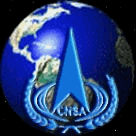China National Space Administration (CNSA)
 Initially Chinese space development efforts were directed by the Ministry of Aeronautics Industry (MOA). This was subsequently combined with the former Ministry of Astronautics Industry to become the new Ministry of Aerospace Industry (MOS) in 1988. With decision of the Chinese government to shift to a more market-oriented economy, the Chinese National Space Administration (CNSA) and the China Aerospace Corporation (CASC) were estblished in June 1993 to promote space activity that would be profit based, and independent of government funding. By the end of 1994 CASC and CNSA had assumed the authority previously held by the Ministry of Aerospace Industry.
Initially Chinese space development efforts were directed by the Ministry of Aeronautics Industry (MOA). This was subsequently combined with the former Ministry of Astronautics Industry to become the new Ministry of Aerospace Industry (MOS) in 1988. With decision of the Chinese government to shift to a more market-oriented economy, the Chinese National Space Administration (CNSA) and the China Aerospace Corporation (CASC) were estblished in June 1993 to promote space activity that would be profit based, and independent of government funding. By the end of 1994 CASC and CNSA had assumed the authority previously held by the Ministry of Aerospace Industry.
After China separated its military and civil space programs in 1998 as part of a ministerial reform, the China National Space Administration is responsible for planning and development of space activities. Its top priority today is the development of piloted space flight, followed by applications satellites.
The principal role of CNSA is to serve as PRC's interface with other national space agencies, while CASC exerts primary control over the national space program. The Asia Pacific Multilateral Cooperation in Space Technology and Applications is coordinated by China National Space Administration. Its activities include the small multi-mission satellite project (SMM) of China, Thailand, Iran and Pakistan; likely future members are South Korea, Mongolia, Sri Lanka and Indonesia.
Although the operational structures of the CNSA and CASC differ, they are in effect a single organization which splits responsibilities for policy making and executive activities. The two organizations share personnel as well as responsibilities. For example, the President of CAC, Liu Jiyuan, was also the Administrator of CNSA. Liu Jiyuan was formerly the Vice Minister of the Aerospace Industry and the Vice President of CAST and is a graduate of the Bauman Polytechnic University in Moscow.(References 60-63).
The National Long- and Medium-term Program for Scientific and Technological Development (2000-2020 Development Program) calls for China to develop space power and propulsion technology, TT&C technology and manned space flight technology, and to maintain China's position in the world's space field. The Sustainable Development Action Plan for the Promotion of China Space Application (Action Plan) envisions the development of high-capacity communications and broadcasting satellites, multi-function earth resources satellites, geostationary meteorological satellites and other application satellites and ground application systems.
|
NEWSLETTER
|
| Join the GlobalSecurity.org mailing list |
|
|
|

